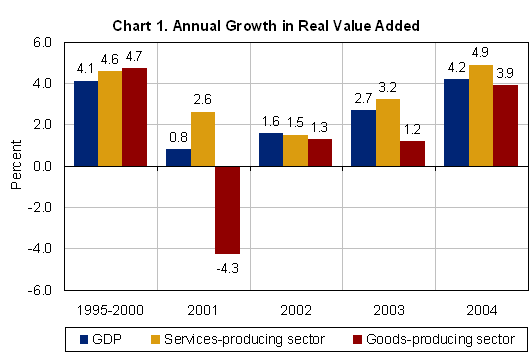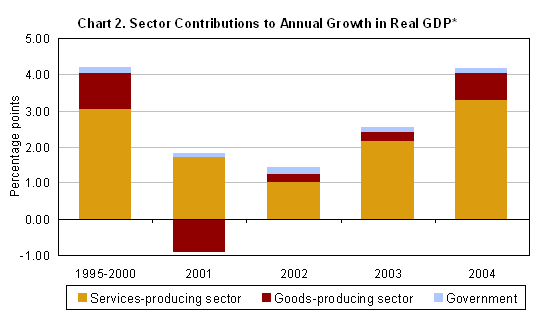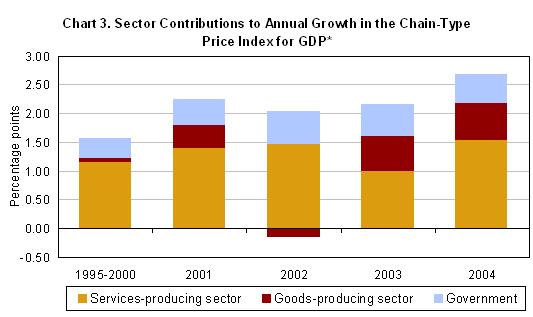 |
Available for this release:  Full Release: PDF, Full Release: PDF,  Charts and Tables: XLS, Charts and Tables: XLS,  Highlights Highlights
 Sign up for Gross Domestic Product by Industry News Releases. Sign up for Gross Domestic Product by Industry News Releases. |
| Technical: |
George M. Smith: |
(202) 606-5307
|
|
BEA 05-53 |
| Media: |
Ralph Stewart: |
606-2649 |
|
|
Expansion in 2004 Led by Services-Producing Sector
|
Revised Estimates of Gross Domestic Product (GDP) by Industry, 2002-2004
|
In 2004, real growth in the U.S. economy was led by the services-producing sector. These industries grew 4.9 percent, reflecting strong increases in real estate and rental and leasing, information, and professional and business services. Newly-available data that provide greater information on the industry composition of growth, released today by the U.S. Bureau of Economic Analysis (BEA), also show that a resurgence in manufacturing boosted real growth in the goods-producing sector to 3.9 percent.
The revised estimates confirm the steady acceleration of growth in the services-producing sector, which exceeded its 4.6-percent average annual growth during the 5-year period preceding the 2001 economic slowdown. These data also clarify that the goods-producing sector grew at an accelerated pace in 2004, after demonstrating relatively flat growth of 1.3 percent in 2002 and 1.2 percent in 2003 (see “Revisions” on page 3).

Source: U.S. Bureau of Economic Analysis
In 2004, the stronger real growth of 4.8 percent in manufacturing led the goods-producing sector to its most robust contribution to U.S. economic growth since 2000. The sector accounted for almost one-fifth of the 4.2 percent real GDP growth in 2004, compared to almost one-tenth in 2003. The real estate and rental and leasing, information, and professional and business services industry groups accounted for three-fifths of the services-producing sector’s contribution to real GDP growth in 2004.

Source: U.S. Bureau of Economic Analysis
GDP price growth was more balanced in 2004. Overall inflation remained low; however, 10 out of 15 private sector industry groups contributed to faster GDP price growth, up from 6 industry groups in 2003. The goods-producing sector contributed about one-fourth of GDP price growth and the services-producing sector accounted for about three-fifths.

Source: U.S. Bureau of Economic Analysis
* Percentage-point contributions do not sum to the percent change in gross domestic product because the contribution of "not allocated by industry" is excluded.
Other highlights of the revised estimates show the following results:
- Real economic growth in 2004 was widespread. All 15 private sector industry groups exhibited positive growth, and 13 of these industry groups grew at a faster rate in 2004 than they did in 2003.
- Information-communications-technology-producing industries increased 12.9 percent in 2004, almost double their growth in 2003. These industries, which include both goods- and services-producing industries, accounted for 11 percent of real GDP growth in 2004, yet comprised just 3.8 percent of current-dollar GDP.
- The finance and insurance industry group accounted for negligible real GDP growth in 2004 after accounting for almost one-fifth of real growth in 2003.
- Durable-goods manufacturing accounted for almost three-fifths of real growth in the goods-producing sector in 2004. Nondurable-goods manufacturing turned up in 2004 – increasing 2.7 percent after decreasing 1.2 percent in 2003. Overall, 16 of 19 manufacturing industries exhibited positive growth.
Revisions
The revised estimates incorporate the most timely, most detailed, and most accurate source data available, including U.S. Census Bureau annual survey and economic census data on industry and commodity output, U.S. Bureau of Labor Statistics data on producer prices, and BEA’s estimates of final demand and industry returns to labor and capital from the 2005 annual revision of the national income and product accounts (NIPAs). These data are combined within an input-output framework that balances and reconciles industry production with commodity usage.
The largest revision to percent change in real value added was for the goods-producing sector in 2003. This sector was revised down 1.6 percentage points, primarily reflecting downward revisions for nondurable-goods manufacturing. Previous estimates showed an acceleration for goods-producing industries from 1.1 percent in 2002 to 2.8 percent in 2003. The revised estimates show a slight deceleration from 2002 to 2003.
| Table A. Revisions to Percent Change in Real Value Added by Industry Group |
| |
2002 |
2003 |
2004 |
| Previously Published |
Revised |
Revision |
Previously Published |
Revised |
Revision |
Previously Published |
Revised |
Revision |
| Gross domestic product |
1.9 |
1.6 |
-0.3 |
3.0 |
2.7 |
-0.3 |
4.4 |
4.2 |
-0.2 |
| Private goods-producing industries |
1.1 |
1.3 |
0.1 |
2.8 |
1.2 |
-1.6 |
3.1 |
3.9 |
0.8 |
| Private services-producing industries |
2.0 |
1.5 |
-0.5 |
3.2 |
3.2 |
0.1 |
5.1 |
4.9 |
-0.2 |
| Government |
1.5 |
1.7 |
0.2 |
1.4 |
1.3 |
-0.1 |
1.2 |
1.0 |
-0.2 |
| Source: U.S. Bureau of Economic Analysis |
BEA’s national, international, regional, and industry estimates; the Survey of Current Business; and BEA news releases are available without charge on BEA’s Web site at www.bea.gov. By visiting the site, you can also subscribe to receive free e-mail summaries of BEA releases and announcements.
* * *
Advance estimates of gross domestic product (GDP) by industry for 2005 will be released on April 27, 2006 at 8:30 A.M. EDT.
| Table 1. Percent Changes in Real Value Added by Industry Group |
| |
|
|
|
|
|
| |
2001 |
2002 |
2003 |
2004 |
Average annual rate of change 1995-2000 |
| Gross domestic product |
0.8 |
1.6 |
2.7 |
4.2 |
4.1 |
| |
|
|
|
|
|
| Private industries |
0.9 |
1.4 |
2.8 |
4.7 |
4.6 |
| Agriculture, forestry, fishing, and hunting |
-6.3 |
5.5 |
7.6 |
1.8 |
6.5 |
| Mining |
-5.3 |
-6.3 |
-1.5 |
2.3 |
-1.1 |
| Utilities |
-4.9 |
4.3 |
7.8 |
1.1 |
1.3 |
| Construction |
0.2 |
-2.0 |
-1.3 |
2.5 |
3.0 |
| Manufacturing |
-5.6 |
2.8 |
1.9 |
4.8 |
5.4 |
| Durable goods |
-6.0 |
1.7 |
4.3 |
6.3 |
8.9 |
| Nondurable goods |
-5.0 |
4.2 |
-1.2 |
2.7 |
0.4 |
| Wholesale trade |
7.0 |
1.0 |
2.2 |
4.6 |
7.2 |
| Retail trade |
7.0 |
2.2 |
3.6 |
6.4 |
6.5 |
| Transportation and warehousing |
-2.6 |
2.2 |
3.7 |
4.0 |
4.4 |
| Information |
4.0 |
2.1 |
2.7 |
12.8 |
8.0 |
| Finance, insurance, real estate, rental, and leasing |
3.9 |
0.9 |
3.4 |
3.8 |
4.4 |
| Finance and insurance |
4.4 |
2.2 |
5.9 |
1.0 |
6.5 |
| Real estate and rental and leasing |
3.5 |
0.1 |
1.9 |
5.6 |
3.1 |
| Professional and business services |
-0.7 |
-0.2 |
3.2 |
6.4 |
5.3 |
| Professional, scientific, and technical services |
0.6 |
-1.5 |
2.3 |
7.1 |
6.9 |
| Management of companies and enterprises |
-1.9 |
3.0 |
3.5 |
6.0 |
1.3 |
| Administrative and waste management services |
-2.8 |
1.2 |
5.2 |
5.2 |
4.1 |
| Educational services, health care, and social assistance |
3.2 |
4.2 |
2.8 |
3.2 |
1.4 |
| Educational services |
-0.2 |
2.6 |
1.1 |
0.8 |
2.1 |
| Health care and social assistance |
3.6 |
4.4 |
3.0 |
3.5 |
1.3 |
| Arts, entertainment, recreation, accommodation, and food services |
-0.7 |
1.7 |
2.9 |
3.0 |
3.7 |
| Arts, entertainment, and recreation |
3.1 |
3.5 |
0.8 |
2.0 |
3.1 |
| Accommodation and food services |
-2.0 |
1.1 |
3.8 |
3.4 |
3.9 |
| Other services, except government |
-1.7 |
0.3 |
1.1 |
1.2 |
0.1 |
| Government |
0.8 |
1.7 |
1.3 |
1.0 |
1.2 |
| Federal |
-1.7 |
2.0 |
1.9 |
1.6 |
-0.4 |
| State and local |
1.9 |
1.5 |
1.0 |
0.7 |
2.0 |
| |
|
|
|
|
|
| Addenda: |
|
|
|
|
|
| Private goods-producing industries 1 |
-4.3 |
1.3 |
1.2 |
3.9 |
4.7 |
| Private services-producing industries 2 |
2.6 |
1.5 |
3.2 |
4.9 |
4.6 |
| Information-communications-technology-producing industries 3 |
-0.4 |
2.0 |
6.7 |
12.9 |
22.1 |
| 1. Consists of agriculture, forestry, fishing, and hunting; mining; construction; and manufacturing. |
| 2. Consists of utilities; wholesale trade; retail trade; transportation and warehousing; information; finance, insurance, real estate, rental, and leasing; professional and business services; educational services, health care, and social assistance; arts, entertainment, recreation, accommodation, and food services; and other services, except government. |
| 3. Consists of computer and electronic products within durable-goods manufacturing; publishing industries (includes software) and information and data processing services within information; and computer systems design and related services within professional, scientific, and technical services. |
| |
|
|
|
|
|
| Source: U.S. Bureau of Economic Analysis |
|
|
|
|
|
| Table 2. Contributions to Annual Percent Changes in Real Gross Domestic Product by Industry Group |
| |
|
|
|
|
|
| |
2001 |
2002 |
2003 |
2004 |
Average annual rate of change 1995-2000 |
| Gross domestic product |
0.8 |
1.6 |
2.7 |
4.2 |
4.1 |
| |
|
|
|
|
|
| Private industries |
0.80 |
1.25 |
2.40 |
4.05 |
4.04 |
| Agriculture, forestry, fishing, and hunting |
-0.06 |
0.05 |
0.07 |
0.02 |
0.08 |
| Mining |
-0.07 |
-0.07 |
-0.02 |
0.03 |
-0.01 |
| Utilities |
-0.10 |
0.08 |
0.15 |
0.02 |
0.02 |
| Construction |
0.01 |
-0.09 |
-0.06 |
0.12 |
0.12 |
| Manufacturing |
-0.80 |
0.36 |
0.24 |
0.59 |
0.83 |
| Durable goods |
-0.51 |
0.13 |
0.31 |
0.44 |
0.80 |
| Nondurable goods |
-0.29 |
0.23 |
-0.07 |
0.14 |
0.03 |
| Wholesale trade |
0.41 |
0.06 |
0.13 |
0.27 |
0.44 |
| Retail trade |
0.46 |
0.15 |
0.24 |
0.43 |
0.44 |
| Transportation and warehousing |
-0.08 |
0.07 |
0.11 |
0.12 |
0.14 |
| Information |
0.19 |
0.10 |
0.12 |
0.56 |
0.35 |
| Finance, insurance, real estate, rental, and leasing |
0.76 |
0.19 |
0.70 |
0.79 |
0.84 |
| Finance and insurance |
0.33 |
0.17 |
0.47 |
0.08 |
0.47 |
| Real estate and rental and leasing |
0.43 |
0.01 |
0.24 |
0.70 |
0.37 |
| Professional and business services |
-0.08 |
-0.02 |
0.36 |
0.73 |
0.57 |
| Professional, scientific, and technical services |
0.04 |
-0.10 |
0.15 |
0.47 |
0.43 |
| Management of companies and enterprises |
-0.03 |
0.05 |
0.06 |
0.11 |
0.02 |
| Administrative and waste management services |
-0.08 |
0.03 |
0.15 |
0.15 |
0.11 |
| Educational services, health care, and social assistance |
0.22 |
0.31 |
0.21 |
0.25 |
0.09 |
| Educational services |
0.00 |
0.02 |
0.01 |
0.01 |
0.02 |
| Health care and social assistance |
0.22 |
0.29 |
0.20 |
0.24 |
0.08 |
| Arts, entertainment, recreation, accommodation, and food services |
-0.03 |
0.06 |
0.11 |
0.11 |
0.13 |
| Arts, entertainment, and recreation |
0.03 |
0.03 |
0.01 |
0.02 |
0.03 |
| Accommodation and food services |
-0.05 |
0.03 |
0.10 |
0.09 |
0.10 |
| Other services, except government |
-0.04 |
0.01 |
0.03 |
0.03 |
0.00 |
| Government |
0.10 |
0.21 |
0.16 |
0.12 |
0.15 |
| Federal |
-0.06 |
0.08 |
0.08 |
0.06 |
-0.02 |
| State and local |
0.16 |
0.13 |
0.09 |
0.06 |
0.17 |
| |
|
|
|
|
|
| Addenda: |
|
|
|
|
|
| Private goods-producing industries 1 |
-0.92 |
0.25 |
0.23 |
0.75 |
1.02 |
| Private services-producing industries 2 |
1.72 |
1.00 |
2.17 |
3.29 |
3.03 |
| Information-communications-technology-producing industries 3 |
-0.01 |
0.08 |
0.26 |
0.47 |
0.85 |
| 1. Consists of agriculture, forestry, fishing, and hunting; mining; construction; and manufacturing. |
| 2. Consists of utilities; wholesale trade; retail trade; transportation and warehousing; information; finance, insurance, real estate, rental, and leasing; professional and business services; educational services, health care, and social assistance; arts, entertainment, recreation, accommodation, and food services; and other services, except government. |
| 3. Consists of computer and electronic products within durable-goods manufacturing; publishing industries (includes software) and information and data processing services within information; and computer systems design and related services within professional, scientific, and technical services. |
| |
|
|
|
|
|
| NOTE. Percentage-point contributions do not sum to the percent change in gross domestic product because the contribution of "not allocated by industry" is excluded. |
| |
|
|
|
|
|
| Source: U.S. Bureau of Economic Analysis |
|
|
|
|
|
|
|